|
Karen and I flew to Launceston then bussed into the suburbs for a short walk to the most conveniently located caravan park a few kilometres outside of town. We were weighed down by heavy packs which contained not only all of our hiking gear, but all the extra clothes and information needed for normal travel in general. In addition, we each carried cameras and binoculars, both a heavy extravagance when carrying a full pack. On the plus side, we were using our regular hiking packs, a welcome luxury after the walks on Fraser and Hinchinbrook Islands when we had been forced to improvise with day packs and bike panniers.
Our first destination was Cradle Mountain. We walked into the heart of Launceston the following morning, picked up our bus passes and were soon headed south and west towards the mountains. Sitting in the bus about ten minutes into our journey, Karen and I spotted our first new birds - the Tasmanian native hen. Scores of them dotted the paddocks on either side of the road. A good start. After brief stops at Deloraine for morning tea, Devonport to pick up passengers just alighting from the ferry from the mainland, and an hour for lunch at Sheffield, we duly arrived at the entrance to the Cradle Mountain national park. The park was gazetted in 1922, and was celebrating its seventy fifth anniversary during our stay.
A camping ground with backpacker accommodation exists near the park entrance, but it is a long way from the start of all the main walking tracks. A regular bus service shuttles walkers to and fro from campground to walks, but Karen and I were deep into tight-arse mode and considered the bus fares extortionate. Instead, we paid ten dollars each for a national parks pass which allowed us to camp in any park in Tasmania for the duration of our stay. A three hour hike along the shore of Dove Lake and past the eastern shoulder of Cradle Mountain took us deep into the park away from the day-use area to the free accommodation of the Scott-Kilvert hut on the edge of Lake Rodway. Karen and I would use the hut as our base for the next four days. We could leave most of our heavy gear at the hut and explore the area with only a day pack each.
The safety of the stuff we left behind at the hut was almost guaranteed. Firstly, most of the people who walk in wilderness areas tend to be honest, caring and concerned individuals. Secondly, there were always a few people around the hut during the day to watch over the gear. Thirdly, Karen and I usually waited until everybody had left the hut before we began our day walks. Fourthly, we always carried our cameras, binoculars, wallets and money with us during the day. Fifthly - and the real clincher - everyone who came to the hut already had their own gear. If they had pinched anything, they would have to carry it out with them, and no hiker wants to carry any extra weight, ever.
The weather had been cool, dry and overcast on our walk in, and was similar when we awoke on our first morning in the park. With no idea what the weather would do over the following days, Karen and I decided to make the most of the clear conditions and climb our primary objective, Cradle Mountain. We retraced our steps of yesterday up past Flynn's Tarn and the postcard picture perfect Artists Pool to the saddle at the base of Cradle Mountain's north-eastern tip, Little Horn. A turn to the west had us tracking across the side of the mountain to the start of the climb from near the emergency shelter of Kitchen Hut.
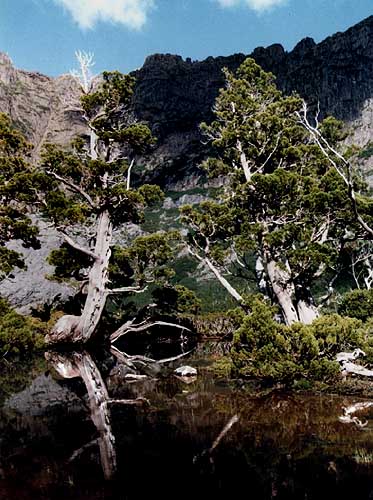
Artists Pool
On our previous visit to this hut, visibility had been about twenty metres, Karen and I had both been soaked from both the climb and the rain, and we had sheltered in the hut for about twenty minutes, Karen making a cuppa for both of us while I applied the first of many band-aids to my heels in a forlorn attempt to stop my new hiking boots from decimating my feet. This time, though, I was wearing KT26's, the best hiking shoe in the world (for me) and my feet were feeling no pain. Visibility was unlimited as we began the ascent.
We passed a couple of struggling tourists whose ambition was greater than their ability, and were in turn passed by a couple of European guys - one carrying a full hiking pack - who were probably accustomed to running up and down the Alps every day and considered the fifteen hundred metres of Cradle Mountain a mere doddle.
The walk up the mountain is constant, but not difficult, and scrambling was only necessary in a few places. Karen and I have discovered a few laws of mountain climbing, the first two of which are "You are never at the top until you are at the top" and "Never say you are almost there". It therefore came as no surprise to us when we reached what appeared to be the top of the climb, only to discover that the track then led downwards through a large, rocky gully and rose again on the other side to the actual trig-topped summit. The third law of mountain climbing - "There is always more room on top of a mountain than you think" - soon made itself evident, with the area of the plateau easily able to accommodate a few football fields. One would not want to kick one's ball over the edge, however.
We ate lunch by the trig, talking to other summiteers as they came and went. Recording the event was the next item on the agenda, with Karen and I posing arm in arm while a fellow hiker snapped our photograph, the rugged peak of Barn Bluff looming in the background. It would be the focus of our next walk. We walked a couple of hundred metres to the eastern edge of Cradle Mountain for more photographs. Below us, the expanse of Lake Rodway appeared tiny, with the Scott-Kilvert hut near its shore a mere dot on the landscape.
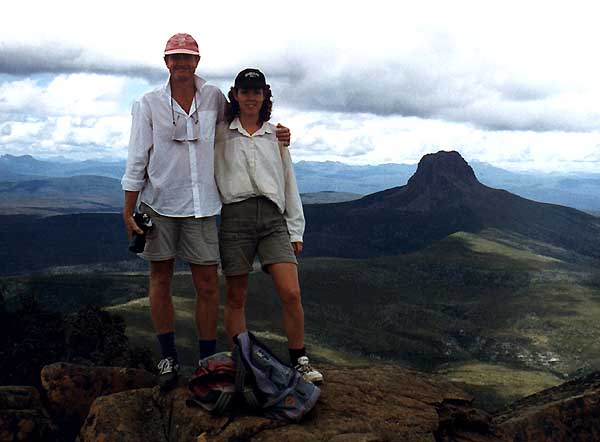
Karen and I atop Cradle Mountain with Barn Bluff beyond
The air at five thousand feet was cool. A small drift of ice and snow still lingered in a sheltered gully, not caring that summer was almost gone. When a slight breeze sprang up and the wind-chill increased, Karen and I took it as a hint to leave. Back at the junction at Kitchen Hut, we turned left and headed south along the Overland Track. We had walked this section before, but had seen nothing but cloud. We soon swung left around Benson Peak and descended to Lake Rodway, having completed the full circuit around Cradle Mountain. We bathed in the cold waters of the lake to remove the grime of the day and retired to the warmth and shelter of Scott-Kilvert Hut.
The hut is about thirty years old, a two storey A-frame, with the lower storey having tables, seats and a fire and mainly used for cooking, eating and drying. The upper storey is a bare, wooden floor used exclusively for sleeping. From where Karen and I were sleeping, Cradle Mountain could be seen through a small window in the front of the hut. We awoke the next morning to see the mountain bathed in bright sunshine. It would be another good day for walking.
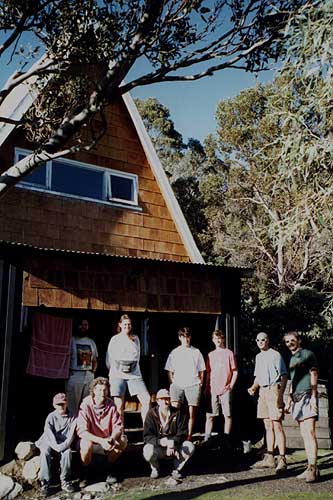
Me (in the middle) outside Scott-Kilvert Hut
At fifteen hundred and fifty nine metres high, Barn Bluff is fourteen metres higher than Cradle Mountain, but as it cannot be seen from the edge of Lake Dove where all the buses stop, most tourists never see it. It may not be as distinctive as Cradle Mountain (which actually takes its name from the cradles used by gold miners and not by babies), but Barn Bluff is still an impressive sight.
Karen and I followed the latter part of yesterday's walk back up to the Overland Track and headed south for about a kilometre before branching off along a ridge leading to the mountain. A lot of the main track is now boardwalk, but the off-shoots are still the traditional boggy ruts familiar to all Tasmanian walkers. At one point we had to cross a small stream. Karen was in the lead and had no hesitation jumping the metre or so across the water and onto a grassy bank on the other side. She suddenly found herself about half a metre shorter, with her legs embedded into the soft ground almost up to her knees! As she struggled do extricate herself, I told her to wait. I grabbed my camera from my day pack and snapped a shot of her posterior for posterity.
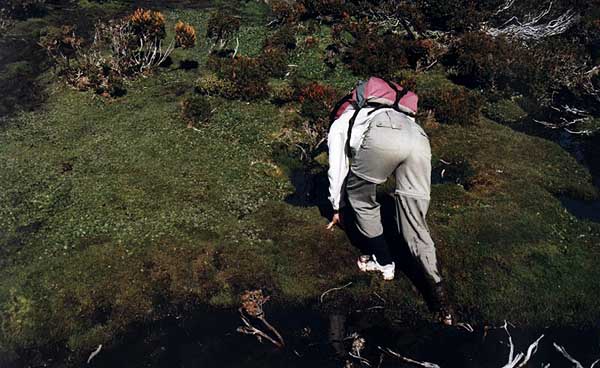
Karen getting into the track
Barn Bluff proved a complete contrast to our climb of the previous day. Both mountains seem to be formed from the same type of dolerite rock, but there the similarities end. Cradle Mountain is solid, with most of its columns and rocks cemented together with soil and alpine grasses. The climb is well marked, the route always obvious and the footing always secure. In comparison, Barn Bluff is more like a stack of rocks just waiting for an opportunity to fall down. The cairned route up its lower slopes led over a large boulder field to steeper slopes of smaller scree. Soil and plants were virtually non-existent, and solid footholds impossible to find in some sections. Sliding off the mountain was a distinct possibility.
The climb had us scrambling over, around and underneath large boulders and through massive columns of rock. Even when we reached the large summit dome we were not completely free from worry. We climbed to the highest point over a thick mass of broken rock which seemed alive. Once in Nepal I had climbed up onto the end of a rock-and-gravel-strewn glacier, all of which was slowly but visibly moving beneath my feet. Although it was probably imagination, I seemed to experience the same sensation on top of Barn Buff. The rocks on the mountain top seemed totally unstable, like a house of cards. We would not have been surprised to see them all crumble away onto the scree slopes below - taking us with them.
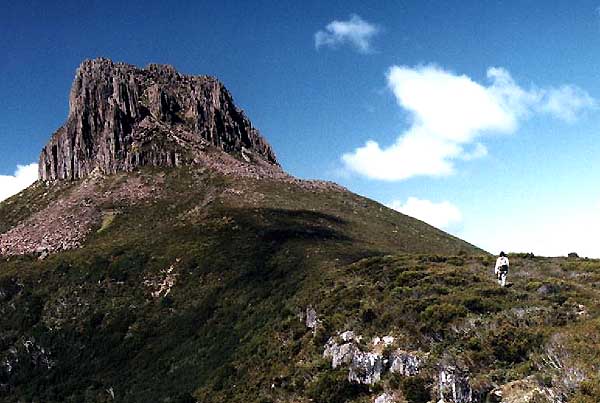
Approaching Barn Bluff
Despite our fears, Karen and I did what we always do when we are alone on top of a mountain and the scenery around us is incredibly beautiful - we took off our clothes. With the camera positioned atop a flat rock, and Karen about ten metres away with Cradle Mountain in the background, I composed the photograph, set the self-timer, pressed the shutter button and quickly flopped over to stand beside my wife, both of us facing tastefully away from the camera. Twice before we had taken similar photographs, on the two thousand metre Mount Angelus in New Zealand, and on top of Mount Owen in the Budawangs National Park in New South Wales.
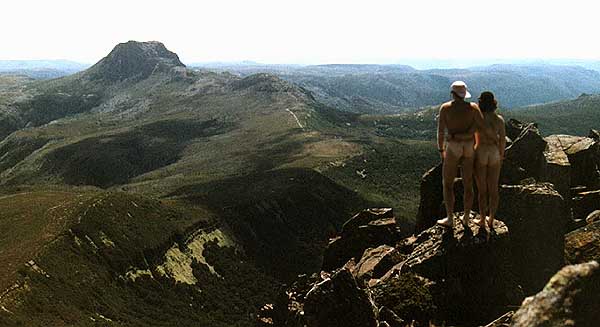
Karen and I atop Barn Bluff with Cradle Mountain beyond
Luckily, the day was warm and sunny and still. We also knew that we would not be surprised by the sudden arrival of other visitors because the entire approach to the mountain could be seen from the top. But if someone had been sitting on top of Cradle Mountain with a good set of binoculars pointed in our direction, they would have copped an eyeful! Don't ask us why we do it - it just seems like a good idea at the time.
We retraced our route in the afternoon, not realising until we arrived back at the hut that we had not seen another human being during the entire walk. Just for a day, Karen and I had been the only two people on the planet. In the evening the air was still warm enough for another swim in Lake Rodway. The top metre of the lake was cool, but refreshingly bearable, but below the surface layer the dark water was frigid. We did not swim for long. Even so, it was hard to believe that we could frolic in the water right next to a hut named after two guys who died of exposure in terrible conditions in the same area thirty years before.
Our third and last big walk from Scott-Kilvert hut had us again walking north past Little Horn to turn left across the face of Cradle Mountain. Soon, however, we diverted right, down a steep and narrow track that drops about two hundred metres to the small Lake Wilks. We then dropped another hundred metres or so in less than half a kilometre to arrive at the Ballroom Forest on the edge of Dove Lake. The forest is mainly composed of myrtle beech trees, with boardwalks winding through its dark interior.
We followed more boardwalks anti-clockwise around the lake, soon spotting a new bird - the Olive Whistler. Two kilometres later we arrived at the northern end of the lake where we had morning tea amongst the tourists and Grey Currawongs near the Lake Dove car park. We had been blessed with yet another beautiful day. During morning tea I talked Karen into another swim. How many people, I argued, will ever be able to say that they swam in Lake Dove, the ripples of their activity the only disruption to the surface which mirrored Cradle Mountain above?
While we were drying off in the sun, we spoke to a photographer who had set up his camera at the water's edge. A slight breeze was rippling the surface, ruining his chance to take a photo of the perfect reflection. We learned that he was a freelance photographer and producer of postcards. He personally delivered displays of his work all over Tasmania to tourist places and souvenir shops on spec, charging the shop-owners nothing. They would receive a percentage of all sales, and did not need to do anything except take in the money. The photographer called back regularly, counted and topped up the stock and picked up the proceeds from the sales, less commission. Karen loved this idea, and plans to institute something similar sometime in the future.
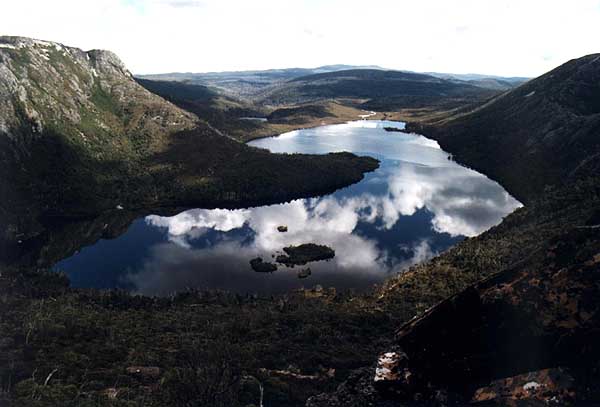
Lake Dove
After the break we walked to Lake Lilla, then around past Wombat Pool for a climb up past Wombat Peak where we rejoined the Overland Track. The aptly named Crater Lake lay below us as we turned south and headed up to Marion's Lookout for lunch. Dove Lake stretched out three hundred metres below us, while Cradle Mountain rose another three hundred metres away to our right. We then crossed the flat expanse of Cradle Plateau to Kitchen Hut, then returned "home" via the Face Track and the Lake Rodway track, both of which were becoming increasingly familiar to us.
The following day, another fine one, we walked out of the park the same way we had come in, apart from a slight diversion to the Twisted Lakes. During our four nights at the Scott-Kilvert Hut we had met and spoken with many interesting people, including Americans, Scandinavians, Pommies and Aussies. We had even met a local named David, from Launceston, who had stayed at the hut for a night with his young daughter, Lauren. Karen had picked David's brains about all the best places to walk in Tasmania, and we had all swapped stories about our adventures on the high seas.
David was a regular competitor in the Three Peaks Race, a combined sailing and running event which involves sailing from Launceston to Hobart with two stops along the way - Flinders Island in Bass Straight, and Coles Bay at the northern end of the Freycinet Peninsula midway down the east coast of Tasmania. At the first stop on Flinders Island, two or more of the crew have to run from the town of Lady Barren to the top of the seven hundred and fifty metre peak of Mount Strzelecki and then return to the boat, a distance of sixty five kilometres! They then sail to Coles Bay where two or more of the crew have to run halfway down the peninsula, climb the six hundred metre Mount Graham and return. They then sail on to Hobart and the finish, except for the run up and down Mount Wellington, which involves a climb of a mere twelve hundred and seventy metres! David is a sailor and a runner in the race. And you thought Karen and I were stupid!
Something about us must have left an impression on David because after we had left the bus at Deloraine and booked into the town's only caravan park for the night, the manageress of the park had handed us a message with David's name and phone number on it. We had no idea how he knew where we would be. We had only stopped in Deloraine because the bus back to Launceston and the bus to our next walk both passed through the town. We not only saved ourselves a bus trip in and out of Launceston, but we also saved ourselves a long walk - the Deloraine caravan park is much closer to a bus stop than the caravan park in Launceston.
Karen rang David and learned that he had rung the caravan parks in Launceston but not been able to locate us, so he had then contacted the bus company to ask where we had been dropped. He had then called the caravan park in Deloraine to leave the message - all so he could invite us to stay at his place the next time we were back in Launceston! David had experienced the joys of travel himself and knew just how much we would appreciate the offer. Karen assured him that we would see him again soon, but first we had a date with the Walls of Jerusalem.
|






